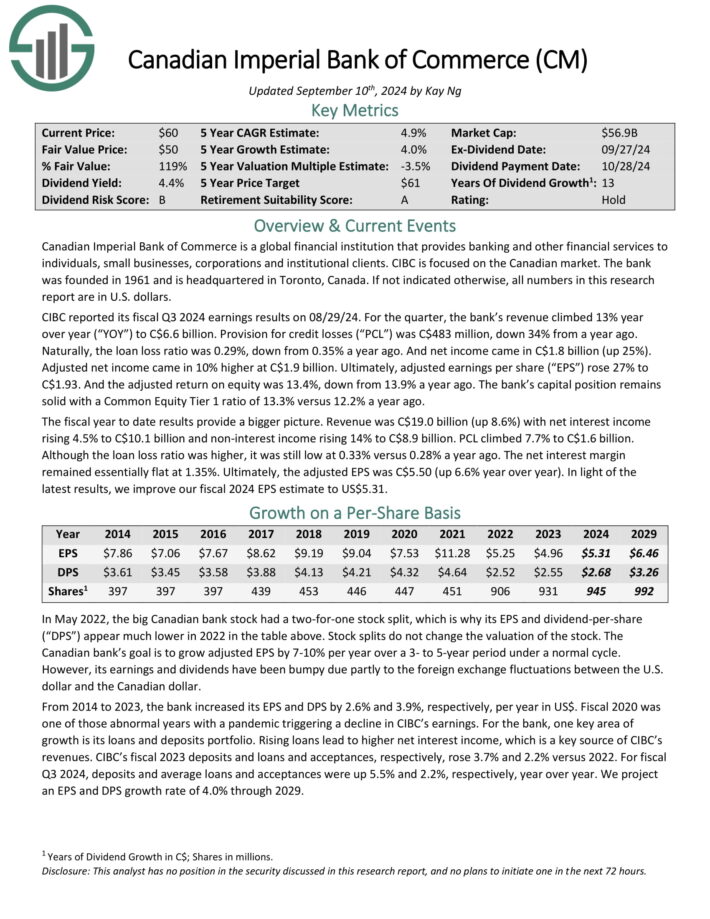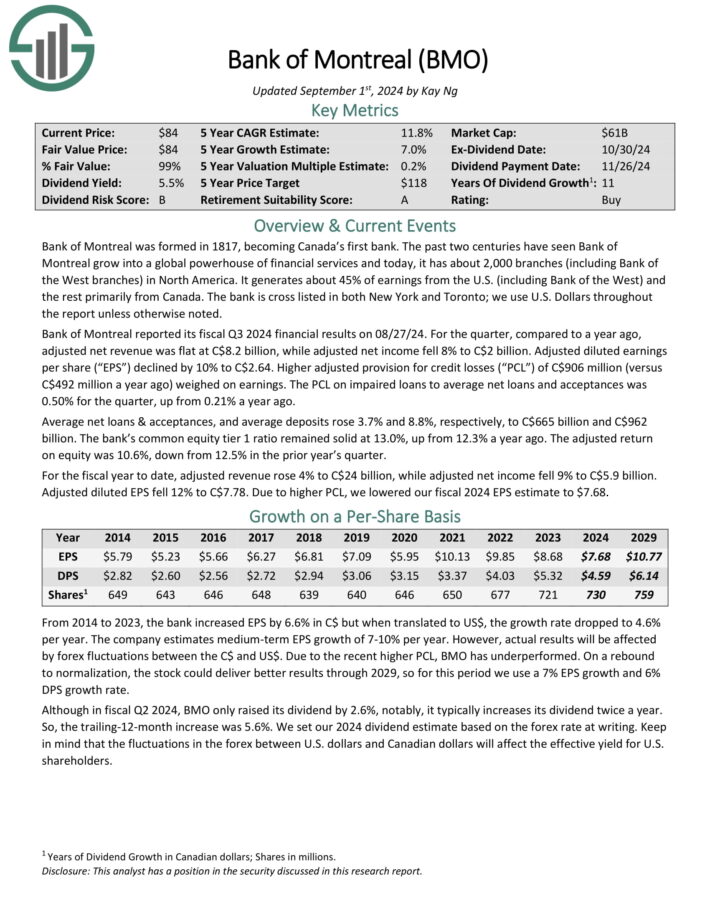Updated on November 19th, 2024 by Bob Ciura
The largest Canadian bank stocks have proven over the past decade that they not only endure recessions, but that they can grow at high rates coming out of a recession as well.
Canadian bank stocks also pay higher dividends than many U.S. bank stocks, making them potentially more appealing for income investors.
Valuations have also remained quite low recently, boosting their respective total return profiles as a result.
In this article, we’ll take a look at the “Big 5” Canadian banks – Canadian Imperial Bank of Commerce (CM), Royal Bank of Canada (RY), The Bank of Nova Scotia (BNS), Bank of Montreal (BMO) and Toronto-Dominion Bank (TD) – and rank them in order of highest expected returns.
Note: Canada imposes a 15% dividend withholding tax on U.S. investors. In many cases, investing in Canadian stocks through a U.S. retirement account waives the dividend withholding tax from Canada, but check with your tax preparer or accountant for more on this issue.
The top 5 big banks in Canada are very shareholder-friendly, with attractive cash returns. With this in mind, we created a full list of financial stocks.
You can download the entire list of 245 financial sector stocks (along with important financial metrics like dividend yields and price-to-earnings ratios) by clicking the link below:


More information can be found in the Sure Analysis Research Database, which ranks stocks based on their dividend yield, earnings-per-share growth potential, and changes in the valuation multiple.
The stocks are listed in order below, with #1 being the most attractive for investors today.
Read on to see which Canadian bank is ranked highest in our Sure Analysis Research Database.
Table Of Contents
You can use the following table of contents to instantly jump to a specific stock:
The top 5 Canadian bank stocks are ranked based on total expected returns over the next five years, from lowest to highest.
Canadian Bank Stock #5: Canadian Imperial Bank of Commerce (CM)
- 5-year expected returns: 3.5%
Canadian Imperial Bank of Commerce is a global financial institution that provides banking and other financial services to individuals, small businesses, corporations, and institutional clients. CIBC was founded in 1961 and is headquartered in Toronto, Canada.
In addition to trading on the New York Stock Exchange, CM stock trades on the Toronto Stock Exchange, as do the other stocks in this article.
You can download a full list of all TSX 60 stocks below:
[memberful does_not_have_subscription_to=”54780-sure-passive-income-3-year,54779-sure-passive-income-annual,54333-sure-retirement-newsletter-3-year-plan,54332-sure-dividend-newsletter-3-year-plan,24803-sure-dividend-newsletter-annual,1326-sure-dividend-newsletter-monthly,24802-sure-dividend-newsletter-quarterly,24694-sure-retirement-newsletter-annual,24804-sure-retirement-newsletter-monthly,26639-sure-dividend-international-newsletter-annual,29061-sure-analysis,32919-sure-analysis-2-year,32920-sure-analysis-3-year,35548-the-sure-retirement-newsletter,35537-the-sure-analysis-research-database,35549-the-sure-dividend-international-newsletter,35547-the-sure-dividend-newsletter,35546-the-sure-analysis-research-database-3-year-plan,35545-the-sure-analysis-research-database-2-year-plan,78797-top-10-dividend-elite-lifetime-plan,80317-top-10-reits-lifetime-plan,85853-the-dividend-pro-plan,85854-the-dividend-ideas-plan”]
[/memberful]
[memberful has_subscription_to=”54780-sure-passive-income-3-year,54779-sure-passive-income-annual,54333-sure-retirement-newsletter-3-year-plan,54332-sure-dividend-newsletter-3-year-plan,24803-sure-dividend-newsletter-annual,1326-sure-dividend-newsletter-monthly,24802-sure-dividend-newsletter-quarterly,24694-sure-retirement-newsletter-annual,24804-sure-retirement-newsletter-monthly,26639-sure-dividend-international-newsletter-annual,29061-sure-analysis,32919-sure-analysis-2-year,32920-sure-analysis-3-year,35548-the-sure-retirement-newsletter,35537-the-sure-analysis-research-database,35549-the-sure-dividend-international-newsletter,35547-the-sure-dividend-newsletter,35546-the-sure-analysis-research-database-3-year-plan,35545-the-sure-analysis-research-database-2-year-plan,78797-top-10-dividend-elite-lifetime-plan,80317-top-10-reits-lifetime-plan,85853-the-dividend-pro-plan,85854-the-dividend-ideas-plan”]
[/memberful]
CIBC reported its fiscal Q3 2024 earnings results on 08/29/24. For the quarter, the bank’s revenue climbed 13% year over year. Provision for credit losses was C$483 million, down 34% from a year ago.
The loan loss ratio was 0.29%, down from 0.35% a year ago. And net income came in C$1.8 billion (up 25%). Adjusted net income came in 10% higher at C$1.9 billion. Adjusted earnings per share rose 27% and the adjusted return on equity was 13.4%, down from 13.9% a year ago.
The bank’s capital position remains solid with a Common Equity Tier 1 ratio of 13.3% versus 12.2% a year ago.
Click here to download our most recent Sure Analysis report on CM (preview of page 1 of 3 shown below):
Canadian Bank Stock #4: Royal Bank of Canada (RY)
- 5-year expected returns: 6.9%
The Royal Bank of Canada is the largest bank in Canada by market capitalization, and by total assets. RBC offers banking and financial services to customers primarily in Canada and the U.S.
The financial institution operates in four core business units: Personal & Commercial Banking (39% of FY2023 revenue), Wealth Management (31%), Insurance (10%), and Capital Markets (20%). Its revenue mix is roughly 59% Canada, 25% the U.S., and 16% international.
On 8/28/24, RBC reported quarterly revenue growth of 13%. Management put aside a reserve of C$659 million in the form of provision for credit losses (“PCL”) that dragged down net income. Earnings-per-share rose 13% year-over-year.
The bank’s capital position was still solid with a Common Equity Tier 1 ratio at 13.0%, down from 14.1% a year ago.
Click here to download our most recent Sure Analysis report on RY (preview of page 1 of 3 shown below):
Canadian Bank Stock #3: Bank of Nova Scotia (BNS)
- 5-year expected annual returns: 8.3%
Bank of Nova Scotia (often called Scotiabank) is the fourth-largest financial institution in Canada behind the Royal Bank of Canada, the Toronto-Dominion Bank and Bank of Montreal.
Scotiabank reports in four core business segments – Canadian Banking, International Banking, Global Wealth Management, and Global Banking & Markets.
Scotiabank reported fiscal Q3 2024 results on 08/27/24. For the quarter, revenue rose 3.7% to C$8.4 billion, while non-interest expenses rose 8.6% to C$4.9 billion.
Provision for credit losses (“PCL”) increased by 28% year over year to C$1.1 billion, which weighed on earnings. As a result, net income fell 13% to C$1.9 billion and diluted earnings per share fell 17% to C$1.41.
The fiscal year-to-date results show a bigger picture. Revenue rose 5.0% to C$25.1 billion. Non-interest expenses increased by 5.9%, while PCL rose 39% to C$3 billion.
The PCL as a percentage of average net loans & acceptances was 0.55%, up from 0.42% a year ago, whereas the PCL on impaired loans as a percentage of average net loans & acceptances was 0.51%, up from 0.38% a year ago.
Click here to download our most recent Sure Analysis report on BNS (preview of page 1 of 3 shown below):
Canadian Bank Stock #2: Bank of Montreal (BMO)
- 5-year expected annual returns: 9.3%
Bank of Montreal was formed in 1817, becoming Canada’s first bank. The past two centuries have seen Bank of Montreal grow into a global powerhouse of financial services and today, it has about 2,000 branches (including Bank of the West branches) in North America.
It generates about 45% of earnings from the U.S. (including Bank of the West) and the rest primarily from Canada. Bank of Montreal generates about 64% of its adjusted revenue from Canada and about 36% from the U.S.
Bank of Montreal reported its fiscal Q4 2023 financial results on 12/1/23. For the quarter, adjusted net revenue declined 25% to C$8.2 billion and adjusted net income rose marginally by 0.7% year-over-year. Adjusted diluted earnings per share declined by 8% year-over-year.
Higher provision for credit losses of C$446 million (versus C$226 million a year ago) as well as a 19% jump in non-interest expense weighed on earnings. The bank’s common equity tier 1 ratio was 12.5%, down from 16.7% a year ago.
Click here to download our most recent Sure Analysis report on BMO (preview of page 1 of 3 shown below):
Canadian Bank Stock #1: Toronto-Dominion Bank (TD)
- 5-year expected annual returns: 12.6%
Toronto-Dominion Bank traces its lineage back to 1855 when the Bank of Toronto was founded. It is now a major bank with C$1.9 trillion in assets. The bank produces about C$14 billion in annual net income each year.
TD reported fiscal Q3 2024 earnings results on August 22nd, 2024. For the quarter, TD reported revenue growth of 10% year-over-year to C$14.2 billion with a net loss of C$181 million.
The net loss was due primarily to setting aside ~C$3.6 billion or C$2.06 per share as provision for the anti-money-laundering issue. Provision for credit losses (PCL) also rose 40% to C$1.1 billion.
Click here to download our most recent Sure Analysis report on TD (preview of page 1 of 3 shown below):
Final Thoughts
Canadian bank stocks do not get nearly as much coverage as the major U.S. banks. However, income and value investors should pay attention to the big 5 Canadian bank stocks.
Royal Bank of Canada, TD Bank, Bank of Nova Scotia, Bank of Montreal, and Canadian Imperial Bank of Commerce are all highly profitable banks.
And, all 5 have reasonable valuations with dividend yields that are well above the U.S. bank stocks.
The following articles contain stocks with very long dividend or corporate histories, ripe for selection for dividend growth investors:
Thanks for reading this article. Please send any feedback, corrections, or questions to [email protected].





